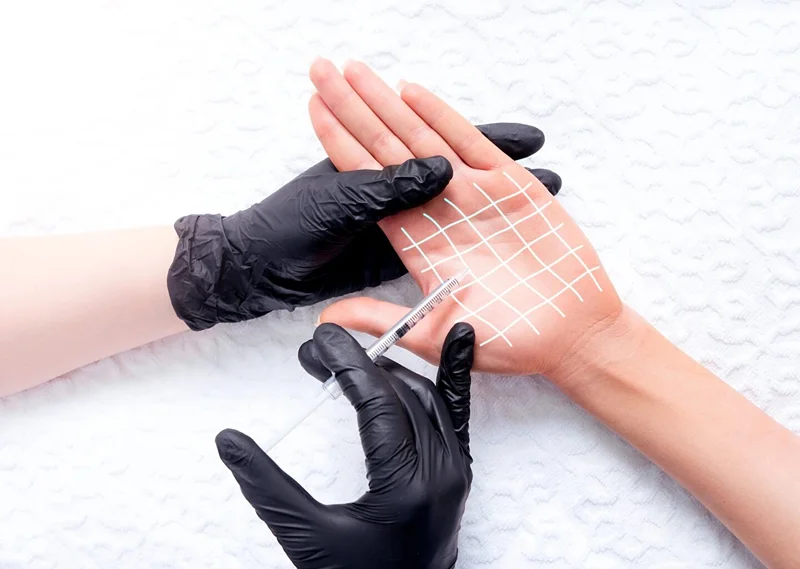Unveiling the Complexities of Excessive Sweating: A Comprehensive Overview to Diagnosis and Administration
Too much sweating, medically referred to as hyperhidrosis, is a problem that affects a substantial variety of individuals and can have a profound influence on their top quality of life. While sweating is a natural bodily feature, its overactivity in hyperhidrosis offers a special collection of challenges that commonly go beyond mere pain. Understanding the underlying reasons, identifying the signs and symptoms, and navigating the diagnostic process for hyperhidrosis can be detailed jobs. In this extensive overview, we will certainly discover the intricacies of hyperhidrosis, from its medical diagnosis to the range of therapy alternatives readily available, losing light on reliable monitoring strategies for those coming to grips with this condition.

Understanding Hyperhidrosis Causes
Hyperhidrosis creates can be connected to various aspects such as genes, hormone discrepancies, and certain medical problems. Genes play a substantial function in key focal hyperhidrosis, where individuals inherit the problem from their household members. By recognizing the specific elements adding to too much sweating, health care carriers can tailor treatment plans to attend to the underlying reason, using alleviation and boosting the quality of life for individuals impacted by hyperhidrosis.
Identifying Hyperhidrosis Manifestations

Additionally, hyperhidrosis signs may materialize in emotional and social distress, as people might feel embarrassed or nervous regarding their sweating, resulting in evasion of social circumstances (How to stop sweaty hands). Additionally, duplicated episodes of excessive sweating can cause skin maceration, fungal infections, and a general decrease in self-worth
Diagnostic Refine for Hyperhidrosis
Initiating the analysis process for too much sweating includes comprehensive examination of the person's clinical history and physical exam. Asking concerning the beginning, period, and triggers of sweating episodes is crucial to differentiate between primary focal hyperhidrosis and additional generalized hyperhidrosis. Clinical background should additionally include concerns concerning medications, medical problems, and household background of hyperhidrosis.
During the checkup, certain interest is paid to the areas impacted by sweating. The doctor might assess the degree of sweating, look for signs of underlying problems, and review the impact of sweating on the person's top quality of life. Furthermore, specific examinations like the gravimetric examination, starch-iodine test, or skin conductance measurements might be conducted to quantify the amount of sweat created.
Furthermore, in cases where secondary hyperhidrosis is thought, extra examinations such as blood tests, urine tests, and imaging studies might be advised to determine the underlying reason for too much sweating. The analysis procedure aims to precisely figure out the type and reason for hyperhidrosis to guide appropriate management strategies.
Therapy Choices for Hyperhidrosis
When resolving extreme sweating, different treatment options are readily available to reduce signs and improve the person's lifestyle. The therapy method for hyperhidrosis depends on the severity of symptoms and the person's feedback to preliminary therapies.
Topical treatments, such as aluminum-based antiperspirants, are often advised as the first line of protection for handling moderate instances of hyperhidrosis. For individuals with extra severe signs additional resources and symptoms, oral drugs like anticholinergics may be recommended to help reduce sweating.

Effective Administration Methods
To efficiently manage hyperhidrosis, a extensive and individualized therapy strategy customized to the individual's details demands and action to previous therapies is vital. This plan may incorporate a combination of healing strategies, consisting of way of life modifications, topical treatments, oral drugs, botulinum contaminant shots, iontophoresis, and in severe instances, medical interventions like sweat gland elimination or sympathectomy. Way of life modifications such as wearing moisture-wicking clothing, making use of antiperspirants, and exercising stress-reducing techniques can complement medical interventions. Topical antiperspirants containing light weight aluminum chloride are commonly the first-line treatment, with stronger solutions available for immune situations. Oral drugs like anticholinergics may be suggested for generalised hyperhidrosis. Botulinum contaminant shots work for focal hyperhidrosis, giving momentary relief by obstructing the release of acetylcholine. Iontophoresis, entailing the usage of a low electrical current to minimize sweat gland activity, can be advantageous for both palmoplantar and axillary hyperhidrosis. Surgical alternatives are usually reserved for serious, refractory look at this now cases and need mindful factor to consider of threats and benefits. A multidisciplinary approach entailing dermatologists, health care doctors, and, if needed, cosmetic surgeons, can maximize the management of hyperhidrosis.
Verdict
In verdict, hyperhidrosis is a problem defined by excessive sweating, which can significantly impact a person's top quality of life. With appropriate diagnosis and management approaches, people experiencing from hyperhidrosis can find alleviation and enhance their general wellness.
Extreme sweating, medically recognized as hyperhidrosis, is a problem that impacts a significant number of people and can have a profound impact on their top quality of life. By determining the particular variables adding to excessive sweating, health care companies can tailor therapy plans to attend to the underlying cause, offering relief and improving the top quality of life for individuals influenced by hyperhidrosis.
Hyperhidrosis, defined by too much sweating beyond what is essential for managing body temperature, can dramatically affect a person's quality of life. Asking concerning the start, duration, and triggers of sweating episodes is crucial to set apart between key focal hyperhidrosis and secondary generalised hyperhidrosis. How to stop sweaty hands.In conclusion, hyperhidrosis is a condition identified by excessive sweating, which can substantially impact a person's quality of life